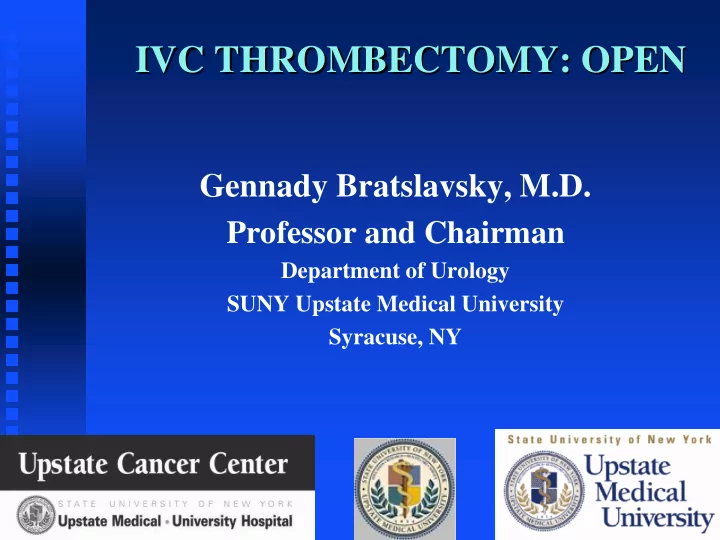

IVC THROMBECTOMY: OPEN Gennady Bratslavsky, M.D. Professor and Chairman Department of Urology SUNY Upstate Medical University Syracuse, NY
Disclosures None I am not an ideal candidate to argue for open IVC thrombectomy
I have performed minimally-invasive IVC thrombectomies since 2011 First level 3 IVC thrombectomy with robot (still the largest one in the literature) with RPLND Last month I have done 2 IVC cases with a robot Direct invasion of the IVC wall in several places requiring complete replacement with Gor-Tex graft T4 with liver invasion and IVC thrombus
49 year old women (350 lbs, ECOG 1)
• Patient discharged 36 hours post op • Path: pT3b, N0, clear cell carcinoma, Grade 3 • 44 lymph nodes negative
Definitions Levels of Tumor Thrombus Suprahepatic Suprarenal III IV I II Infrarenal 12% 5% 42% 22% <2 cm into IVC Intracardiac Suprarenal
Yet, I will argue for OPEN technique today For majority, the robotic IVC is still a VERY selected group Level 1 does not count True level 3 with Pringle and suprahepatic control is too long and dangerous Level 4 is not there yet Video at the AUA “controlled piece meal removal”
Venous involvement in RCC Patients Incidence % Authors Venous invasion 4-36 Skinner, 1972 Novick, 1980 Marshall, 1988 Hatcher, 1991 Pouliot, 2010 IVC extension 3-5 Kearney, 1981 Libertino, 1987 Atrial extension 0.5-1.0 Neves/ Zincke, 1987
Surgical Principles for Tumor Thrombectomy 1. Assemble experienced team Anesthesia +/- Hepatobiliary, vascular, cardiac surgery 2. Operate on vessels first (preserve collateralized veins if IVC occluded) 3. Ligate renal artery, no need to embolize 4. Isolate venous structures 5. Completely remove thrombus 6. Manage any distal bland thrombus 7. Repair/patch/replace IVC as needed 8. Complete nephrectomy and LND
Exposure is Everything Choice of incision Location of tumor Body habitus Veins to be isolated Costal flare
Avoid Preoperative Embolization IVC VTT cases 135 with, 90 without embolization Embolization: blood loss, complications, mortality MVA revealed 5 fold increased risk of per operative death in patients with embolization Several large series against embilozation Subramanian, Urology 2009
Right Medial Visceral Rotation to Expose Suprarenal IVC Retrohepatic Divide ligaments to fully mobilize liver
Tumor Thrombus: Level III Technique Renal artery ligation Mobilize liver for suprahepatic IVC access 4 3 Sequence for venous control: 1. Contralateral renal vein 2. Distal IVC, incl. 2nd lumbar vein 3. Hepatic inflow (Pringle maneuver) 4. Suprahepatic IVC (above thrombus) 1 Remove thrombus or get it below the hepatic veins Occlude IVC below hepatic inflow 2 Release suprahepatic IVC & Pringle Repair vena cava leisurely Complete nephrectomy
Tumor Thrombus: Level IV Technique Veno-veno bypass Cardiopulmonary bypass Cardiopulmonary bypass with hypothermic (16 ºC) circulatory arrest Advantages: bloodless field, ~60 minutes of ischemia time Hypothermic arrest is associated with longer OS and significant reduction in perioperative mortality Disadvantages: need for anticoagulation and reversal
Inferior Vena Cava Reconstruction Critical to achieve complete removal of intraluminal thrombus as well as tumor infiltrating into vein wall Vein wall invasion may be difficult to recognize grossly – frozen section margins useful Patch preferred over graft, if possible Infrarenal IVC resection without replacement if vein chronically occluded Replacement of para- and supra-renal IVC with low threshold to re-implant renal veins
55 y/o man with renal cell carcinoma and level IV tumor thrombus: Avoided sternotomy: Foley (level IV to level III)
Outcomes of Nephrectomy and IVC Tumor Thrombectomy (pre targeted therapy) ALL levels Median Survival (mos.) 5-yr. DSS(%) Follow- up Author Yr n No mets Mets No mets Mets Haferkamp 2007 111* 52 11 46 6.5 16 Karnes/Blute 2008 614** --- --- 55 13 --- Klatte 2007 321 116 16 65 19 25 Lambert 2007 118 --- --- 61 --- 18 Sweeney 2003 96 38 20 40 28 25 Modified from Pouliot, et al. J Urol. 2010
• 162 patients • Level 3: 69 • Level 4: 93 • Major complications: 34% • 90 day mortality: 10.4% • ECOG>1 and low albumin predicted mortality Eur Urol, 2013
Changing the paradigm: Prof. Vsevolod Matveev Blokhin Cancer Center, Moscow Russia)
Conclusions OPEN surgery can provide durable survival and remains preferred approach for most cases in most centers Meticulous attention to management of vascular anatomy is mandatory: Vessels first approach! Experienced multidisciplinary teams can assure low morbidity/mortality Potential for minimally invasive surgery and sternotomy- free approach
SUNY Upstate Department of Urology
Recommend
More recommend